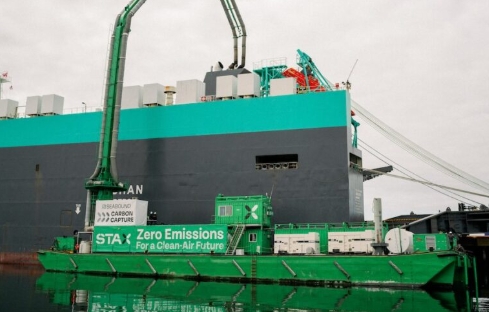
Canada could leverage investments in nuclear capacity - like the GEH's BWRX-300 small modular reactor envisaged for deployment at OPG's Darlington site - to decarbonise heating (Image: GEH)
The energy used to heat buildings in Canada is roughly equivalent to the country's entire electricity generation. But current plans to achieve net-zero buildings through electrification of heating systems and retrofitting millions of existing buildings to reduce energy demand may not prove "feasible or affordable" at the required scale by 2050 - the date set by the Canadian government to achieve net-zero.
Thermal Networks (TNs) offer an "alternative and complementary" pathway, the study finds. Thermal networks are district energy systems that harvest, produce, store and distribute heat through a network of insulated, buried water pipes. More than 200 existing district energy systems currently meet about 3% of Canada's total heat demand, but up to 70% of the Canadian population could be serviced by such networks, the study suggests. Thermal networks already supply more than 50% of the heating needs in some European "cold-climate" countries, and Canada can learn from these experiences.
Sharing non-emitting combined heat and power (CHP) generators offers synergies for electricity grids and thermal networks with strategic benefits such as reducing demand for additional clean heat generation. It can also help to support grid modernisation, by using large thermal storage to accept variable heat at the convenience of shared CHP generators. "As such, thermal network infrastructure can be viewed as an enabler of the electrification of other sectors," the report notes.
Nuclear is "among the largest of clean CHP generators", the paper says, and Canada is already intending to significantly increase its nuclear energy capacity by 2050 as part of its net zero transition. The primary focus for new nuclear capacity has up to now been on its ability to produce clean baseload electricity, but harnessing the CHP capabilities of nuclear energy to also service thermal networks could leverage Canada's strategic investment to help reduce the need for additional clean heat.
Nuclear energy, in CHP mode, could service thermal networks in two ways. Firstly, nuclear power plants built to provide baseload electricity could be configured for CHP operations, providing heat that can be stored and transported via so-called thermal corridors at distances "upwards of" 100 km to suitable thermal networks. Secondly, small or micro modular reactors, operating in CHP mode, could be constructed as integral elements of thermal networks, with "perhaps hundreds" of such reactors providing CHP for thermal networks across Canada. Analysis suggests that nuclear energy could provide upwards of 25-50% of the nation’s total thermal network heat supply, the report finds.
The paper proposes that Canadian governments collaborate to develop a Thermal Network Strategy aimed at identifying and supporting thermal network infrastructure investments, and recommends measures including, amongst other things, the recognition of heat as a strategically important form of energy; the formal recognition of thermal networks as part of Canada’s energy critical infrastructure; and an assessment of the business case to configure nuclear power plants, at all scales, for CHP where they can provide economic heat to thermal networks.
The position paper, Thermal Networks and Nuclear Energy: Advancing the Dialogue on Clean Heat Infrastructure for Canada, was released at the Canadian Nuclear Association's annual conference in Ottawa.







